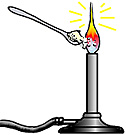Evidence for Spectral Lines
 Can you tell me more about the experiments showing that different elements made
different spectral lines?
Can you tell me more about the experiments showing that different elements made
different spectral lines?
 Spectral lines were first seen in the sun's spectrum by William Wollaston in 1802.
However, they were not systematically studied until 1814, when a German optician named
Joseph von Fraunhofer observed and catalogued them. Fraunhofer carefully recorded the
positions of the lines, but he didn't attempt to explain why they were there. In the
late 1850's, the physicist Gustav Kirchhoff decided to investigate further, with the
help of the chemist Robert Bunsen.
Spectral lines were first seen in the sun's spectrum by William Wollaston in 1802.
However, they were not systematically studied until 1814, when a German optician named
Joseph von Fraunhofer observed and catalogued them. Fraunhofer carefully recorded the
positions of the lines, but he didn't attempt to explain why they were there. In the
late 1850's, the physicist Gustav Kirchhoff decided to investigate further, with the
help of the chemist Robert Bunsen.
 Did he invent the Bunsen burner?
Did he invent the Bunsen burner?
 Yes, and that's what Bunsen and Kirchhoff used to perform their experiments. They held
various substances in the flame of a Bunsen burner. The light emitted from the heated
elements was separated into spectra using a prism.
Yes, and that's what Bunsen and Kirchhoff used to perform their experiments. They held
various substances in the flame of a Bunsen burner. The light emitted from the heated
elements was separated into spectra using a prism.
|

|
 And they found that each element had its own unique set of lines?
And they found that each element had its own unique set of lines?
 They certainly did. A given element would always produce the same spectrum, which was
different from that of any other element. In fact, in the 1860's, Kirchhoff and Bunsen
discovered two new elements, cesium and rubidium, when they came across some spectral
lines that didn't fit any of the known elements. Later, the elements of gallium,
helium, argon, neon, krypton, and xenon were also discovered using spectroscopy.
They certainly did. A given element would always produce the same spectrum, which was
different from that of any other element. In fact, in the 1860's, Kirchhoff and Bunsen
discovered two new elements, cesium and rubidium, when they came across some spectral
lines that didn't fit any of the known elements. Later, the elements of gallium,
helium, argon, neon, krypton, and xenon were also discovered using spectroscopy.






